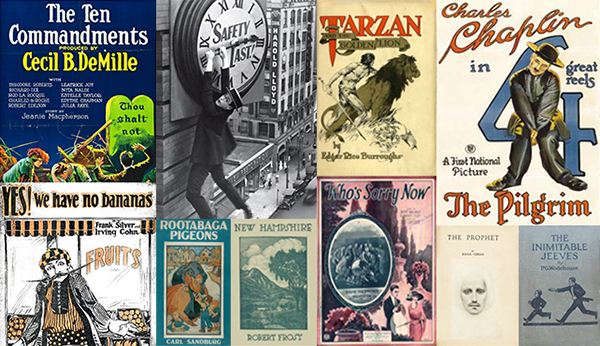
As the clock struck midnight on New Year’s Eve, hundreds of thousands of works were released into the public domain. January 1, 2019, otherwise known as Public Domain Day, marked the release of scores of books, musical compositions, paintings, poems, photographs, and films originally published in 1923. As a result of Public Domain Day, anyone is now free to republish, recreate, or adapt any of these works for use in new works. This occasion marks not only the first time a public domain dump has occurred in 21 years but also, the beginning of a new annual tradition.
Copyright is a form of intellectual property law that protects original works of authorship, including literary, dramatic, musical, and artistic works, such as poetry, novels, paintings, movies, songs, and architecture. When one owns a copyright to a work, that individual or entity holds exclusive rights for its use and distribution for a limited time and subject to certain limitations and exceptions. Copyright protections date back to the original grant in the Constitution giving Congress the right to right to bestow exclusive rights to a creator for limited times. Indeed, Article I Section 8 Clause 8 provides Congress the power “[t]o promote the progress of science and useful arts, by securing for limited times to authors and inventors the exclusive right to their respective writings and discoveries.”
The first copyright act in 1790 provide a 14-year copyright term with the option to apply for an automatically granted 14-year renewal. This original version of the copyright act attempted to strike a balance between providing an incentive to authors, artists, and scientists to create original works but also to limit their monopoly in order to stimulate advancement of science and the useful arts. In 1909, the term, as well as, the automatically granted renewal doubled to 28 years. Additionally, the 1909 act broadened the scope of categories to include all works of authorship. Again, in 1976, the law was changed to harmonize with the Berne Convention. The Berne Convention provides the basis of mutual recognition of copyright between sovereign nations. In this amendment, the period was again extended, this time to the life of the author plus 50 years.
Finally, in 1998, Congress passed the Sonny Bono Copyright Term Extension Act, adding 20 years to the terms of older works. The Act was named after the entertainer and Representative from California’s 44th Congressional District who had died unexpectedly in a skiing accident earlier that year. Sonny Bono’s colleagues in Congress dedicated the copyright extension legislation, of which Bono was a major proponent, to his memory.
The Sonny Bono-named act fixed a period of 95 years for anything placed under copyright protection from 1923 to 1977. After 1977, the expiration measure is not fixed but rather, is based on when an author perishes. In effect, by the time the act was passed, previously-copyrighted works from 1922 and before were already released into the public domain but works from 1923 and beyond would be subject to copyright protection until this year. In other words, the advancement date of the public domain for works covered by the older fixed term copyright rules was effectively frozen. However, the Act did not revive copyrights that had already expired.
Proponents of the copyright term extension argued that the life expectancy of humans had risen dramatically since Congress passed the original copyright act in 1790. Further, proponents also claimed that extending the copyright term would align U.S. law with Europe’s under the Berne Convention. Individuals and entities such as Disney, the Gershwin family trust, and the grandchildren of Oscar Hammerstein were amongst those who pushed for the extended copyright term.
Those opposed to the Sonny Bono Act claimed that the legislation was only aimed at corporate welfare and that most works bring a majority of the overall profits during the first few years after publication. Interestingly, many of the proponents of the act were those whose works were still generating significant revenues in the 1990s. Thus, the argument follows that extending the copyright term resulted in a windfall to the companies and families that owned these copyrights. Opponents also argued that patent terms have not been extended in parallel and that patents adequately reward investment in the field with a 20-year term.
Assuming Congress does not interfere again, more works will continue to fall into the public domain each January from now on. In January 2021, The Great Gatsby will fall into the public domain. This will be followed by the release of Ernest Hemingway’s The Sun Also Rises in January 2022. Then, in January 2024, Steamboat Willie’s copyright will expire and with it, the original incarnation of the film’s star, Mickey Mouse. While Disney will no longer have an exclusive copyright over the original depiction of Mickey, the company still retains its copyrights for later incarnations of the character and of course, all of its Mickey-related trademarks. Moreover, between 2031 to 2035, the copyrights to Superman, Batman, Snow White, and early Looney Tunes characters will all fall into the public domain.
